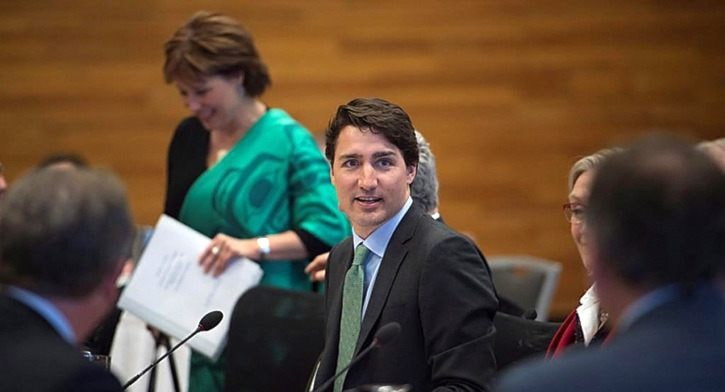Premier Christy Clark had her dancing shoes on as yet another B��Ԫ������ַ�climate changeB��Ԫ������ַ� meeting ended in disarray in Vancouver last week.
B��Ԫ������ַ�This is not the end,B��Ԫ������ַ� Clark assured reporters after Prime Minister Justin Trudeau and the premiers emerged with no agreement on a national minimum carbon price. No kidding.

Trudeau declared victory by announcing the unanimous consent to a B��Ԫ������ַ�Vancouver Declaration,B��Ԫ������ַ� which basically pays lip service to the concept of B��Ԫ������ַ�carbon pricingB��Ԫ������ַ� and kicks another grand federal election promise down the road.
[Vancouver Declaration . Its first promise is to "increase the level of ambition." No kidding.]
As the rest headed for jets waiting at Vancouver airport, Clark expressed the hope that the public would say B��Ԫ������ַ�they got together and they made progress.B��Ԫ������ַ� Did they? LetB��Ԫ������ַ�s take a look.
Going into the Whistler-Vancouver stop on TrudeauB��Ԫ������ַ�s globe-trotting glamour tour, Clark correctly noted that itB��Ԫ������ַ�s other provinces that need to make progress. B.C. has a clear price on carbon emissions; itB��Ԫ������ַ�s been held at $30 a tonne since Clark succeeded its creator, Gordon Campbell.
ClarkB��Ԫ������ַ�s advice for other premiers is to follow CampbellB��Ԫ������ַ�s example of a revenue-neutral carbon tax, offset by income tax reductions. You wonB��Ԫ������ַ�t build public support for a carbon tax that makes people poorer, she said.
Of course thatB��Ԫ������ַ�s what Alberta is doing, at a time when many residents are getting poorer already. AlbertaB��Ԫ������ַ�s NDP government plans to match the rate of B.C.B��Ԫ������ַ�s carbon tax within two years and spend the proceeds.
Other premiers have more creative definitions for pricing carbon.
Nova Scotia Premier Stephen McNeil pointed to transmission lines and power purchases from the Muskrat Falls dam under construction in Labrador, to substitute hydro for coal-fired power. The highest electricity prices in Canada are their B��Ԫ������ַ�carbon pricingB��Ԫ������ַ� plan.
Saskatchewan Premier Brad Wall pointed to SaskPowerB��Ԫ������ַ�s Boundary Dam carbon capture and storage project. It is the worldB��Ԫ������ַ�s first coal-fired power station to capture carbon dioxide after combustion. The CO2 is sold to oilfield operators who inject it into declining wells to push more oil out, and the project intends to capture sulphur dioxide and fly ash to process and sell for other industrial uses.
Wall is the only Canadian leader to state a couple of inconvenient truths. The purpose of this exercise is to reduce carbon emissions, not to raise tax revenues. And now is the worst possible time to impose more taxes on the oil and gas industry.
ClarkB��Ԫ������ַ�s stand-pat strategy on the B.C. carbon tax is going to change this year, as positioning begins for the 2017 election. A B.C. government advisory panel has recommended a 33 per cent increase, conveniently starting in 2018, with annual increases after that.
The current seven-cent-per-litre carbon tax on gasoline sold in B.C. is hardly a deterrent these days, as pump prices have tumbled and could stay low for years to come. And with a fragile economy, it seems unlikely that a big boost in carbon taxes will find favour with voters a year from now.
The B.C. NDP is trying to rebuild its credibility on climate policy. NDP leader John Horgan tried to revise the partyB��Ԫ������ַ�s history, claiming in year-end interviews that the NDP didnB��Ԫ������ַ�t oppose the carbon tax, only making it revenue neutral rather than spending the money on green initiatives, as Alberta wants to do.
Alas, the NDPB��Ԫ������ַ�s B��Ԫ������ַ�axe the taxB��Ԫ������ַ� campaign going into the 2009 election is a matter of record. The partyB��Ԫ������ַ�s election platform warned that CampbellB��Ԫ������ַ�s plan B��Ԫ������ַ�increases taxes for average families by tripling the gas taxB��Ԫ������ַ� to its current level.
Last week the NDP issued a news release denouncing Clark for presiding over increasing greenhouse gas emissions.
Tom Fletcher is B.C. legislature reporter and columnist for Black Press. Email: tfletcher@blackpress.ca Twitter: @tomfletcherbc



